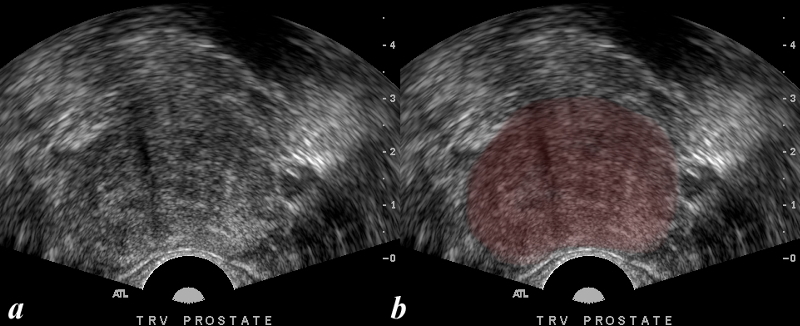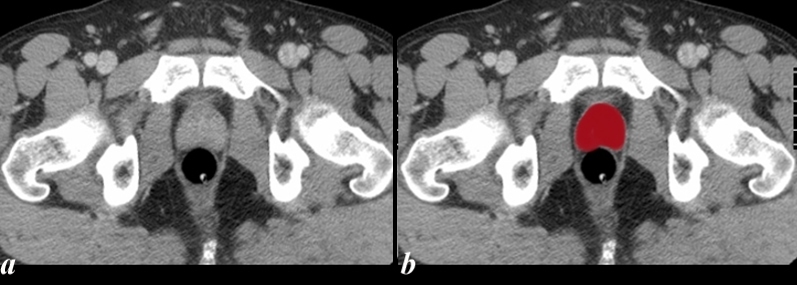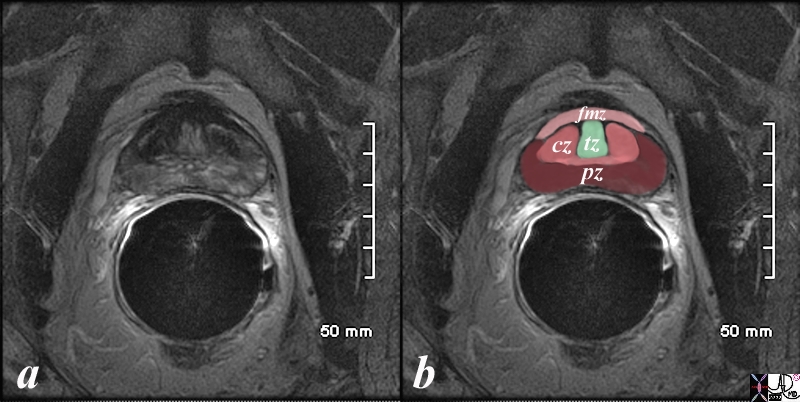The Common Vein Copyright 2010
Introduction
The character of the prostate is based on its feel on palpation. Clinical examination of a normal prostate gland reveals a combination of features that describe it as smooth, elastic and “rubbery”. Galen described it as that “spongy flesh at the side of the neck of the urinary bladder”. Abnormalities of the prostate felt on direct clinical examination are nodules, induration, bogginess or fluctuance.
Character of the prostate on imaging
Ultrasound
The prostate gland on ultrasound is almost isoechoic and the gains have to be finely tuned on the ultrasound equipment in order to bring out the subtle differences in the texture of the gland and the surrounding tissue.
|
Transrectal Ultrasound in Transverse View |
|
The transrectal transverse view of the prostate shows a normal sized prostate almost homogeneous in texture with echogenicity being isoechoic and very similar to surrounding tissue. The distinction between the peripheral zone, transition zone, central zone and fibromuscular layer is not obvious on this image ad is usually difficult to distinguish. Image b represents an overlay of the prostate to accentuate the position of the prostate. Image Courtesy Ashley Davidoff Copyright 2010 98724c.8 |
Character on CT scanning
The normal prostate has non specific features on CT scan and demonstrates soft tissue density similar to the muscle surrounding it. The distinction between the various zones of the prostate usually cannot be appreciated on the normal gland.
|
Normal Size Shape and Characterof the Prostate 26 Year Old Male CTscan Isodense to Soft Tissue |
|
The CTscan is from a 26 year old male with a normal prostate seen in the axial plane (a,b). Note the shape of the gland in the transverse plane is heart shaped and it is homogeneous in texture and isodense to muscle. Image Courtesy Ashley Davidoff Copyright 2010 99331c02.8s.5 |
MRI Characteristics
MRI is the imaging modality that best characterizes the prostate. The T2 weighted sequence optimizes the distinction between the peripheral, central, transitional zones and the anterior fibrous layer
|
Normal Zonal Anatomy MRI T2 Weighted |
|
The patient is a 60 year old man. His MRI was performed with a transrectal coil and the image shows the T2 weighted sequence in the axial projection (a,b). The peripheral zone (pz), central zone (dark pink, cz) the transitional zone (light green), and the fibromuscular zone (light pink, fmz) – are easily distinguished. The glandular elements in the peripheral zone make this zone T2 bright. The presence of fibrous tissue and muscle in the central zone and anterior fibromuscular layer kake them dark on T2. The elements in the transitional zone make them bright on T2 weighted imaging. Image Courtesy Ashley Davidoff MD Copyright 2010 98877c.8s |



